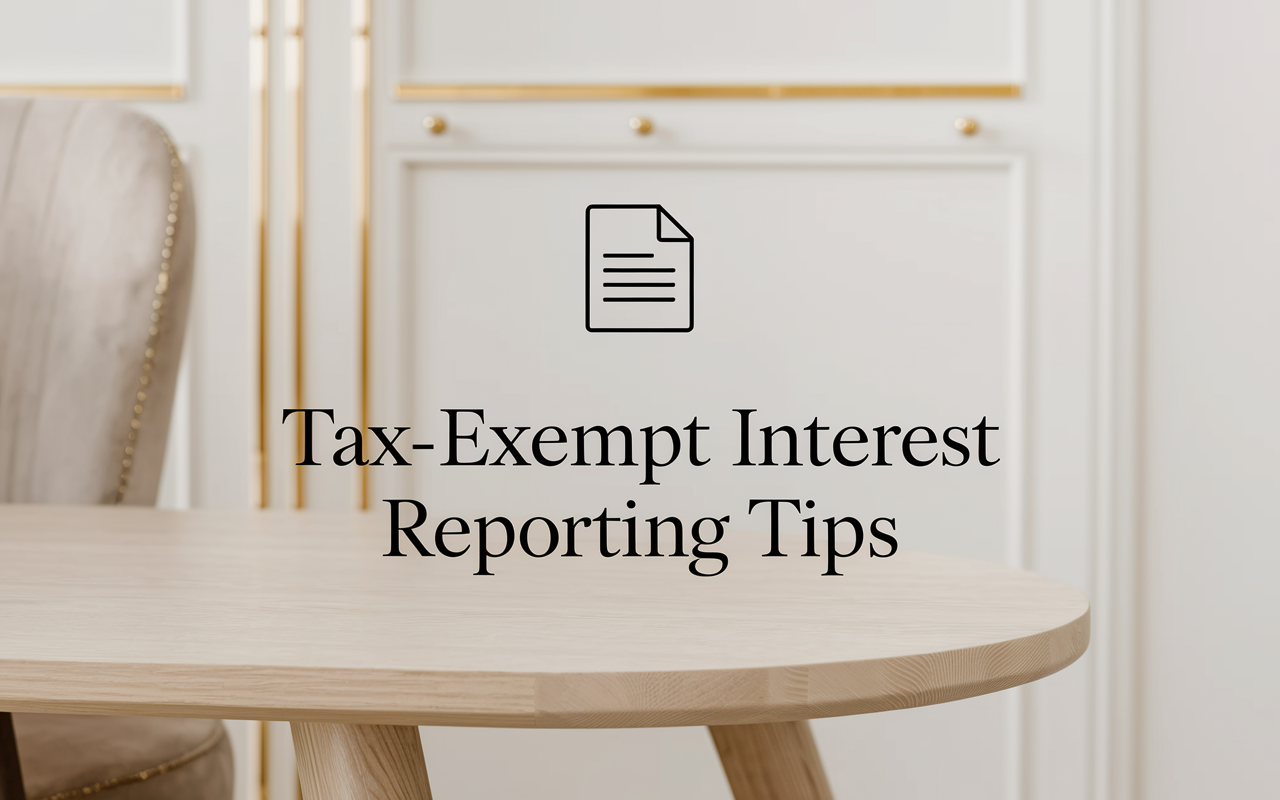Best Practices for Reporting Tax-Exempt Interest on Form 1040
Introduction
Few moments in retirement planning cause as much confusion as tax time. While many retirees focus on their taxable income, they sometimes overlook the importance of reporting tax-exempt interest income on 1040. This oversight can lead to incorrect filings, IRS inquiries, and unexpected ripple effects on benefits like Social Security. Even if you’re a federal or military employee with decades of service, properly documenting tax-exempt income can be crucial to your overall financial health.
At PlanWell, our professionals carry specialized credentials—ChFEBC, CFP, and AIF—and have created the Fed-Expert Financial Blueprint to guide federal employees toward confident retirements. A central part of this blueprint includes understanding how every piece of your income, including municipal bond interest or certain government securities, ties into your financial roadmap. Even though tax-exempt interest does not typically increase your federal income tax liability, it does play a role in calculating thresholds for Social Security benefits and can open the door to state or local tax obligations. Below, we’ll walk through why and how to report tax-exempt interest on Form 1040 and share best practices tailored for federal workers aged 55+ preparing for or navigating retirement.
Overview of Tax-Exempt Interest
Tax-exempt income generally comes from municipal bonds or other specific government or municipal securities designed to spur public projects. The interest from these types of bonds is normally free from federal income tax, but don’t let the label “tax-exempt” fool you into thinking it’s irrelevant for your return—a portion of it may affect other taxes or financial calculations.
For example, many states do not recognize out-of-state municipal bonds as tax-exempt. In other words, if you live in Virginia and invest in municipal bonds issued by another state, you might owe taxes to the Commonwealth of Virginia. And, crucially for retirees, tax-exempt interest can still factor into your federal tax picture when it comes to determining the taxable portion of Social Security benefits. While it may not add to your taxable income on the federal level, it can inflate your “provisional income,” which the IRS uses to decide how much of your Social Security will be subject to tax.
It’s important to remember you must still report tax-exempt interest on your Form 1040. This ensures compliance with IRS rules and provides an accurate record of your overall financial position. Even a small amount of such income needs to appear on your return. If you’re wondering, “If it’s not taxed, why report it?”—the answer is that the IRS wants a complete picture to gauge any other potential tax obligations (like the Alternative Minimum Tax) correctly.
Relevant IRS Forms and Reporting Requirements
While every taxpayer’s situation can vary, three forms typically play the largest role in reporting tax-exempt interest.
Form 1099-INT
Financial institutions or brokers issue Form 1099-INT if you earn at least $10 in interest, whether taxable or tax-exempt. You’ll find tax-exempt interest in Box 8. This detail is especially important for mutual fund investors who receive “exempt-interest dividends” alongside their regular interest or dividends. It can also include interest from bonds issued by U.S. territories, which are generally tax-exempt on the federal level. If you do not receive a 1099-INT but believe you should have, follow up with your bank or financial institution to ensure all forms match your records.
Form 1040, Line 2a
Once you know the total amount of tax-exempt interest from all sources, enter that figure on Line 2a of your Form 1040. Although this amount doesn’t flow into your taxable income calculation, it proves vital for other parts of your return. Be sure to keep your records handy—in the event of an audit, the IRS wants to confirm you have properly distinguished between taxable and non-taxable interest.
Schedule B (Form 1040)
If your total taxable interest and dividends exceed $1,500, you may need to file Schedule B. Tax-exempt interest is not counted in that $1,500 threshold, but certain additional disclosures—like foreign accounts or nominee distributions—might place you in a situation where you need to provide more details. For many retirees, especially those with multiple income sources or investment accounts, Schedule B is a natural extension of reporting interest and dividends accurately.
Best Practices for Reporting
We often see retirees, especially those serving in the federal or military sectors, struggle with the exact steps to ensure accurate—and compliant—returns. Below are some tried-and-true approaches our firm recommends.
Maintain Accurate Records. Gather all necessary 1099-INT forms, interest statements, and brokerage reports well before tax season. Double-check to confirm you haven’t missed an account. Even if you’re retired, you may still have multiple old savings accounts or bonds that trickle in small bits of interest throughout the year.
Separate Your Taxable and Tax-Exempt Interest. Early in the year, or whenever you receive monthly or quarterly statements, note which interest categories fall under which bucket. This clear delineation cuts down on confusion and fosters a smoother filing process. Taxable interest goes on Line 2b, and tax-exempt interest belongs on Line 2a of the 1040.
Bond Premium & Nominee Distributions. One reason financial planning for retirees can get complicated is the presence of municipal bonds bought at a premium. If you amortize that premium each year, it lowers the amount of interest you report as tax-exempt. Similarly, if you received interest in your name that actually belongs to someone else (a nominee situation), make sure to subtract that distribution on your return and issue the proper 1099-INT to the rightful recipient.
State & Local Tax Issues. If you own municipal bonds from a state other than your own, recognize that tax-exempt might not apply at the state level. Understanding these cross-jurisdictional nuances can prevent surprises. Always confirm whether your home state taxes out-of-state municipal bond interest.
Coordinate with Social Security Benefits. Although it doesn’t add to federal tax due, tax-exempt interest can increase your “provisional income,” which the IRS applies to figure out how much of your Social Security benefits will be taxed. This is a pivotal reason why the “it’s not taxable, so why report it?” perspective can be misleading. Reporting it properly ensures you’re calculating your Social Security taxes accurately.
To see an example of how tax-exempt interest shows up differently from taxable interest, below is a quick reference table you might find useful:
|
Interest Type |
Form 1099-INT Box |
Form 1040 Line |
Notes |
|---|---|---|---|
|
Taxable Interest |
Box 1 |
Line 2b |
Included in federal taxable income |
|
Tax-Exempt Interest |
Box 8 |
Line 2a |
Affects Social Security calculations, but not federal tax |
As you can see, even though tax-exempt interest appears on a separate line on your return, it still plays a role in other calculations. That’s why thorough recordkeeping is critical for retirees balancing multiple forms of income.
Special Considerations for Federal Employees
Federal and military employees—either approaching retirement or already receiving pensions—commonly ask how these bonds can impact their pensions and other government benefits. Here are a few pointers that might help you:
FERS and Military Pensions. Your pension increases your adjusted gross income (AGI). Even though tax-exempt income doesn’t count toward AGI, it does count toward your provisional income for Social Security taxation. That synergy can bump up how much of your Social Security benefits get taxed.
Thrift Savings Plan (TSP). Distributions from your Thrift Savings Plan (TSP) are federally taxable. Combined with tax-exempt interest, these distributions could move your provisional income over the thresholds that determine if 50% or 85% of your Social Security is taxable. That’s one reason an integrated strategy is key—our firm’s Fed-Expert Financial Blueprint aims to streamline these interactions so you’re not paying more taxes than necessary or missing potential benefits.
Because these layers of rules can become intricate, it’s wise to consult with a planner who understands both the tax code and your federal benefits. Our firm has guided numerous clients through this process, helping them clarify how best to structure their portfolio and retirement cash flow. To learn more about these strategies, feel free to Sign up for one of our free Federal Retirement Planning Workshops. We host FERS-specific webinars designed for employees at all stages of retirement readiness.
Common Errors and How to Avoid Them
In our 30+ years serving federal workers, we’ve seen a few repeat missteps. They’re easy to do inadvertently, but correcting them can save you from potential letters from the IRS.
Forgetting to Report. Because it doesn’t add to your taxable income, many assume “it doesn’t matter.” Then they omit it entirely. The IRS still wants to see it on your return, so filtering out those 1099-INT forms can lead to penalties or audits.
Bond Premium Overreporting. If you buy a municipal bond above par (the face value), the portion above par is your “premium.” Each year, some of that premium can reduce the tax-exempt interest you report. For instance, if you normally receive $2,000 in interest but have to amortize a $200 bond premium, your reportable tax-exempt interest becomes $1,800. Here’s a simplified illustration:
|
Year |
Municipal Bond Interest Received |
Bond Premium Amortized |
Reportable Tax-Exempt Interest |
|---|---|---|---|
|
2022 |
$2,000 |
$200 |
$1,800 |
|
2023 |
$2,000 |
$200 |
$1,800 |
In the table above, the amortized premium each year reduces the reportable amount, which should go on Line 2a of your Form 1040. Missing that detail can create small but meaningful discrepancies.
Backup Withholding Confusion. If an institution took backup withholding out of your tax-exempt income, don’t forget to claim it on the “Payments” portion of your 1040. Failing to do so means you might miss out on a credit you’re entitled to.
Conclusion
Your retirement finances embody more than just pension checks and Social Security deposits. Even items that don’t add directly to your federal tax bill—like tax exempt interest income on 1040—can have hidden implications when it comes to benefit thresholds and state taxes. Properly separating taxable from tax-exempt interest, adjusting for bond premiums, and keeping track of each line on your Form 1040 ensures your tax strategy is airtight.
For federal or military employees, especially those over 55, a comprehensive plan that accounts for these nuances can be the difference between a smooth, confident retirement and unintended tax headaches. If you have questions about your own municipal bonds, TSP distributions, or how best to integrate everything under one cohesive plan, our ChFEBC, CFP, and AIF professionals are here to help. We specialize in offering a financial advisor for federal employees approach that addresses these unique considerations. Consider joining one of our free FERS webinars or in-person Federal Retirement Planning Workshops to learn more: Sign up for one of our free Federal Retirement Planning Workshops.
Because every aspect of your retirement income puzzle needs to fit seamlessly, reporting your tax-exempt interest accurately is more than just a box to check—it’s a cornerstone for preserving your benefits and peace of mind.










